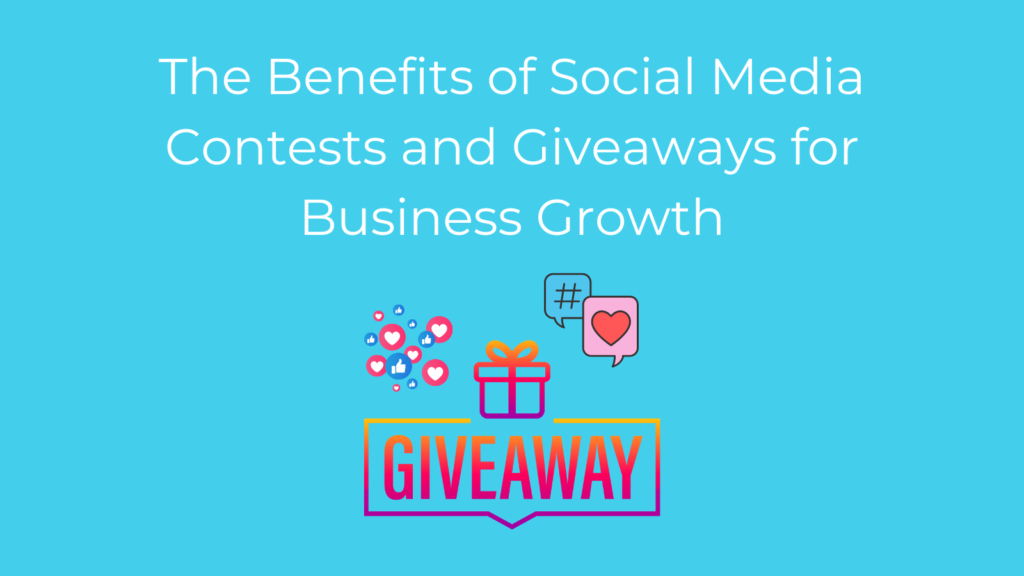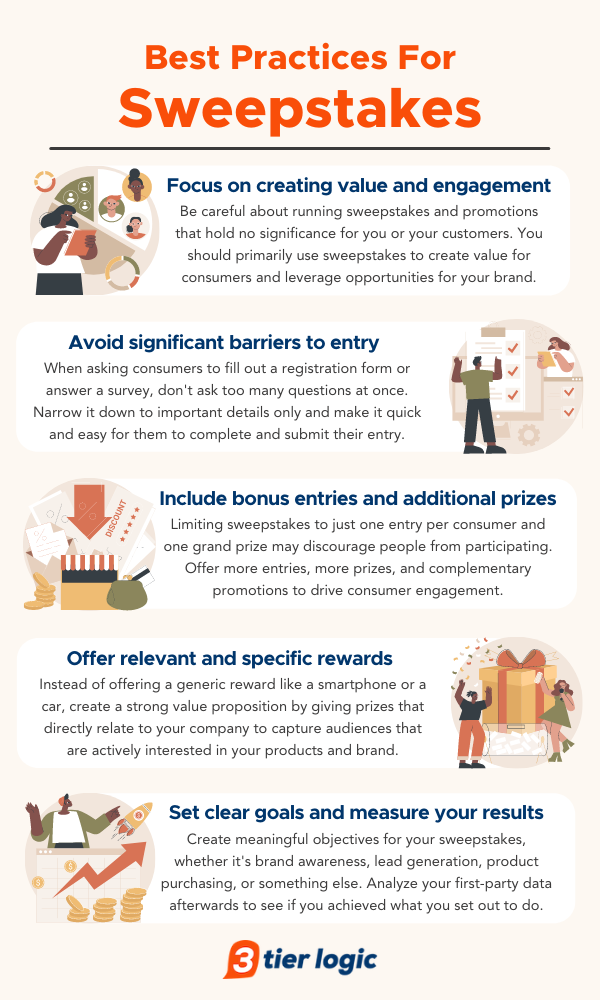You may not realize it, but contests and giveaways have a significant impact on advertising strategies. These promotional tactics not only attract attention but also engage consumers, fostering brand loyalty and boosting sales. Whether it’s the thrill of competition or the prospect of winning something for free, contests and giveaways create a buzz that can generate valuable exposure for businesses. In this article, we will explore the diverse ways in which contests and giveaways play a crucial role in advertising, paving the way for successful marketing campaigns. So, buckle up as we embark on an exciting journey into the world of promotional contests and giveaways! Contests and giveaways play a crucial role in advertising by providing a unique opportunity for brands to engage with their target audience and create a buzz around their products or services. These promotional activities can help increase brand awareness, generate customer engagement, and build brand loyalty. Moreover, contests and giveaways allow companies to collect valuable data and build a customer database, while also driving traffic to physical and online stores. In this article, we will explore the importance of contests and giveaways in advertising, the different types of contests and giveaways, the benefits they offer, best practices for running them, legal considerations to keep in mind, how to measure their success, and common mistakes to avoid. We will also highlight some successful examples of contests and giveaways that have made a significant impact on popular brands.
Increasing Brand Awareness
Contests and giveaways are excellent tools for increasing brand awareness. When a brand organizes a contest or giveaway, it generates excitement and captures the attention of potential customers. By participating in the contest or giveaway, individuals become familiar with the brand and its offerings. Furthermore, when participants share their participation on social media or with their friends and family, it further amplifies the brand’s reach and increases its visibility. Through these activities, contests and giveaways help brands reach a broader audience and leave a lasting impression on potential customers.
Generating Customer Engagement
One of the primary objectives of contests and giveaways in advertising is to generate customer engagement. When individuals participate in a contest or giveaway, they become actively involved with the brand. They may need to complete specific tasks, such as submitting their contact details, answering questions, or creating user-generated content. This engagement creates a deeper connection between the brand and the customer, fostering a sense of loyalty and building trust. Moreover, contests and giveaways often encourage participants to interact with the brand’s social media accounts or visit their website, giving them a chance to explore the brand further and discover its offerings.
Building Brand Loyalty
Contests and giveaways provide an excellent opportunity for brands to build and strengthen brand loyalty. When individuals participate in a contest or giveaway, they develop a sense of affinity towards the brand. By offering attractive prizes or exclusive experiences, brands can create a positive association in the minds of customers. This positive experience reinforces customer loyalty and encourages repeat purchases or engagement with the brand in the future. Additionally, when participants have a positive experience with a contest or giveaway, they are more likely to recommend the brand to their friends, family, and social media followers, further enhancing brand loyalty.
Collecting Data and Building Customer Database
Contests and giveaways allow brands to collect valuable customer data and build a comprehensive customer database. When individuals enter a contest or giveaway, they typically provide their contact details, such as their name, email address, and sometimes their phone number or social media handles. This data can then be used by brands for various marketing purposes, such as sending targeted email campaigns, personalized offers, or conducting market research. By building a customer database through contests and giveaways, brands can establish a direct line of communication with their customers and tailor their marketing efforts effectively.
Driving Traffic to Physical and Online Stores
Contests and giveaways can effectively drive traffic to both physical and online stores. By placing entry mechanisms in specific locations or on a brand’s website, contests and giveaways create an incentive for individuals to visit these spaces. For physical stores, this can result in increased foot traffic and the potential for additional sales or brand interactions. For online stores, contests and giveaways can drive website traffic, increase the time spent on the site, and potentially lead to higher conversion rates. By strategically planning contests and giveaways, brands can attract both new and existing customers to their stores, providing a boost to their overall sales and brand visibility.
Now that we understand the importance of contests and giveaways in advertising, let’s explore the different types that brands can utilize to achieve their marketing objectives.

This image is property of globalowls.com.
Types of Contests and Giveaways
Social Media Contests
Social media contests have become increasingly popular in recent years, thanks to the widespread use of platforms such as Facebook, Instagram, Twitter, and YouTube. These contests typically require participants to engage with the brand’s social media account by liking, commenting, sharing, or creating content using a specific hashtag. Social media contests can quickly generate a significant amount of user-generated content and increase brand visibility by leveraging the participants’ social networks. Moreover, they offer a convenient platform for brands to interact with their audience, respond to comments or queries, and build a community around their products or services.
Email Contests
Email contests involve brands collecting entries and contact details from participants through email submissions. These contests are often promoted through the brand’s website, social media channels, or existing email marketing campaigns. By asking participants to provide their email addresses, brands can build an email subscriber list and send targeted marketing communications directly to potential customers. Email contests can also be an effective way to reward loyal customers, as brands can target their existing email subscribers with exclusive contests and giveaways. This approach encourages continued engagement with loyal customers and can lead to higher conversion rates and sales.
In-Store Contests
In-store contests are an excellent way for brands to interact with customers who visit their physical stores. These contests can take various forms, such as lucky draws, scratch cards, or competitions that require participants to complete specific tasks within the store. In-store contests offer a unique opportunity for brands to promote their products or services directly, showcase new releases or special offers, and create a memorable experience for customers. Additionally, in-store contests provide an effective way for brands to collect customer information and encourage future visits or purchases through exclusive rewards or discounts.
Online Giveaways
Online giveaways involve brands offering free products, services, or experiences to participants through their website or other online platforms. These giveaways typically require participants to provide their contact information to enter, and winners are selected randomly or through a specific criteria-based selection process. Online giveaways can be an effective way for brands to attract potential customers and create a positive association with their offerings. By offering valuable prizes, brands can generate excitement and incentivize individuals to participate, increasing their chances of becoming future customers.
Sweepstakes
Sweepstakes are a popular type of contest that gives participants the chance to win prizes through a random drawing. Participants typically enter the sweepstakes by providing their contact information, such as their name and email address, or by completing specific tasks, such as sharing the sweepstakes on social media or referring friends. Sweepstakes are often used by brands as a way to quickly generate a large number of entries, create buzz, and increase brand visibility. They offer participants a simple and straightforward entry mechanism, making it easy for individuals to get involved and potentially win exciting prizes.
Now that we have explored the different types of contests and giveaways, let’s delve into the benefits they offer in terms of advertising and marketing strategies.
Benefits of Contests and Giveaways in Advertising
Cost-Effective Marketing Strategy
Contests and giveaways provide brands with a cost-effective marketing strategy that can deliver a high return on investment. Compared to traditional advertising methods, such as television or print ads, organizing contests and giveaways is relatively affordable. The cost of prizes and promotional materials is often offset by the increased brand visibility, potential sales, and customer engagement that these activities generate. Moreover, the use of social media platforms and online tools for promoting contests and giveaways further reduces marketing costs, making them an attractive option for brands with limited budgets.
Word-of-Mouth Marketing
Contests and giveaways have the potential to generate powerful word-of-mouth marketing for brands. When individuals participate in a contest or giveaway, they often share their experience with friends, family, and colleagues, either in person or through social media. This word-of-mouth marketing can significantly amplify the brand’s reach and influence, as recommendations from trusted sources carry more weight than traditional advertisements. Furthermore, when participants have a positive experience with a contest or giveaway, they are more likely to spread the word about the brand to their network, creating a ripple effect that can lead to increased brand awareness and customer acquisition.
Collecting Customer Feedback
Contests and giveaways provide an excellent opportunity for brands to collect valuable customer feedback. When individuals participate in a contest or giveaway, they may be required to answer questions, provide feedback on their experience with the brand, or share their opinions about specific products or services. This feedback can give brands valuable insights into customer preferences, satisfaction levels, and areas for improvement. By actively listening to their customers’ feedback, brands can enhance their offerings, provide better customer experiences, and ultimately strengthen their competitive advantage in the market.
Creating User-Generated Content
User-generated content (UGC) is a powerful marketing tool that can significantly boost brand visibility and engagement. Contests and giveaways often encourage participants to create and share UGC, such as photos, videos, or written content. This UGC showcases individuals’ experiences with the brand’s products or services and can be leveraged by the brand in their marketing efforts. By featuring UGC on their website, social media accounts, or other marketing channels, brands can showcase real-life customer experiences, enhance authenticity, and build trust with their audience. Moreover, UGC provides a valuable source of content for brands, reducing the need for constant content creation and diversifying their marketing materials.
Increasing Social Media Following
Contests and giveaways can significantly increase a brand’s social media following, allowing them to engage with a larger audience and expand their reach. By requiring participants to engage with the brand’s social media accounts, such as following, liking, or sharing posts, contests and giveaways drive organic growth in terms of followers and engagement. This increased social media following provides brands with a captive audience for their future marketing efforts, such as launching new products, promoting exclusive offers, or sharing valuable content. Additionally, a larger social media following can enhance a brand’s credibility and influence, making them more attractive to potential customers and business partners.
Now that we understand the benefits of contests and giveaways in advertising, let’s explore some best practices for running successful contests and giveaways.
Best Practices for Running Contests and Giveaways
Set Clear Goals and Objectives
Before running a contest or giveaway, it is essential to set clear goals and objectives. What do you hope to achieve through this promotional activity? Are you looking to increase brand awareness, generate customer engagement, or drive sales? By clearly defining your goals, you can structure your contest or giveaway in a way that aligns with these objectives. Moreover, setting specific and measurable goals allows you to track the success of your campaign and make necessary adjustments if needed.
Choose the Right Prize
Selecting the right prize is crucial for the success of your contest or giveaway. It should be something that resonates with your target audience and offers significant value. The prize can be one of your own products or services, a special experience, or something related to your industry that your audience would find appealing. By offering an attractive prize, you can incentivize participation and generate excitement. However, it is essential to ensure that the prize is relevant to your brand and aligns with your overall marketing strategy.
Determine the Entry Mechanism
The entry mechanism for your contest or giveaway should be clear, straightforward, and easy to follow. Consider the level of effort you want participants to invest and choose an entry mechanism that suits your goals. For example, if you want to drive social media engagement, you can ask participants to like, comment, or share a post. If you want to collect customer data, you can require participants to provide their contact details. The entry mechanism should be clearly communicated to participants, and any additional steps or requirements should be easy to understand and complete.
Establish Rules and Regulations
To ensure fairness and transparency, it is essential to establish clear rules and regulations for your contest or giveaway. These rules should outline eligibility criteria, entry deadlines, prize details, selection criteria, and any other relevant information. By clearly communicating the rules, you can avoid any confusion or disputes and create a positive experience for participants. It is also recommended to review local regulations and legal requirements related to contests and giveaways to ensure compliance.
Promote the Contest or Giveaway
Promoting your contest or giveaway plays a crucial role in its success. Utilize various marketing channels to spread the word and reach your target audience. This can include social media platforms, email marketing campaigns, your brand’s website, online advertisements, or collaborations with influencers or other brands. It is important to craft compelling copy and visuals that capture the attention of your audience and clearly communicate the benefits of participating. Additionally, consider offering incentives for participants to share the contest or giveaway with their networks to further expand its reach.
Now that we are familiar with the best practices for running contests and giveaways, let’s dive into some legal considerations that brands need to keep in mind to ensure compliance and protect their reputation.

This image is property of images.squarespace-cdn.com.
Legal Considerations for Contests and Giveaways
Compliance with Local and International Laws
When running contests and giveaways, it is crucial to comply with local and international laws related to promotions and advertising. These laws can vary significantly by jurisdiction and may include requirements related to eligibility, prize disclosures, entry methods, and prize fulfillment. To ensure compliance, it is recommended to consult with legal professionals who specialize in marketing and advertising laws to review your contest or giveaway structure and ensure that it adheres to all applicable regulations.
Disclosure Requirements
In many jurisdictions, there are specific disclosure requirements that brands must follow when running contests and giveaways. These requirements typically include clearly communicating the terms and conditions of the contest or giveaway to participants, including eligibility criteria, entry deadlines, prize details, selection criteria, and any other relevant information. Additionally, if the contest or giveaway involves any partnerships or collaborations, it is important to disclose these relationships to participants to maintain transparency and avoid any potential conflicts of interest.
Age Restrictions
Many contests and giveaways have age restrictions to ensure compliance with child protection laws and prevent minors from participating in activities that may be unsuitable for their age. It is crucial to clearly communicate the age restrictions in your contest or giveaway rules and verify the age of participants, especially when valuable prizes are involved. Failure to comply with age restrictions can have legal repercussions and damage the brand’s reputation.
Avoiding Misleading or Deceptive Advertisements
When promoting contests and giveaways, it is essential to avoid any misleading or deceptive advertisements that may misinterpret the terms, conditions, or benefits of participation. Brands should ensure that their promotional materials clearly and accurately represent what participants can expect from the contest or giveaway. This can include providing realistic information about the odds of winning, any hidden costs or requirements, and any limitations on the prizes or benefits. By maintaining transparency and avoiding misleading advertisements, brands can build trust with their audience and protect their reputation.
Intellectual Property Rights
Brands running contests and giveaways need to be mindful of intellectual property rights, including trademarks, copyrights, and image rights. It is essential to ensure that the contest or giveaway does not infringe upon any third-party intellectual property rights, such as using copyrighted material without permission or featuring trademarked logos or images without proper authorization. Failure to respect intellectual property rights can result in legal consequences and damage the brand’s reputation. It is recommended to seek legal guidance to navigate any potential intellectual property issues.
Now that we understand the legal considerations associated with contests and giveaways, let’s explore how brands can measure the success of their promotional activities and evaluate their impact on marketing strategies.

This image is property of www.gourmetmarketing.net.
Measuring the Success of Contests and Giveaways
Tracking Entries and Participation
One of the fundamental ways to measure the success of a contest or giveaway is by tracking the number of entries and participation. Monitoring the volume of entries received can provide insights into the level of interest and engagement generated by the promotional activity. Additionally, tracking the demographics of participants, such as age, location, or interests, can help brands understand whether they are reaching their target audience effectively.
Analyzing Social Media Engagement
For contests and giveaways conducted through social media platforms, analyzing social media engagement metrics is essential for measuring success. These metrics can include likes, comments, shares, mentions, and hashtag usage. By monitoring social media engagement, brands can assess the reach and impact of their promotional activities, understand audience sentiment, and identify potential influencers or brand advocates.
Monitoring Website Traffic
Contests and giveaways that drive traffic to a brand’s website offer an opportunity to measure success through website analytics. Monitoring website traffic metrics, such as unique visitors, page views, time on site, and conversion rates, can indicate the level of interest and engagement generated by the contest or giveaway. By analyzing these metrics, brands can identify areas for improvement, optimize their website experience, and potentially increase overall sales or brand interactions.
Measuring Brand Reach and Exposure
Contests and giveaways have the potential to significantly increase a brand’s reach and exposure. By monitoring brand reach metrics, such as impressions, reach, or media mentions, brands can gauge the impact of their promotional activities on brand visibility. This data can be collected through social media analytics, media monitoring tools, or surveys conducted with contest participants. Measuring brand reach and exposure can help brands assess the effectiveness of their marketing efforts and make informed decisions about future contests or giveaways.
Evaluating Conversion Rates
For brands that aim to drive sales or conversions through contests and giveaways, evaluating conversion rates is crucial. By tracking the number of contest participants who convert into paying customers or take any desired action, such as making a purchase, signing up for a subscription, or completing a survey, brands can measure the impact of their promotional activities on their bottom line. Evaluating conversion rates allows brands to identify the most effective contests or giveaways and adjust their marketing strategies accordingly.
Now that we have explored various methods to measure the success of contests and giveaways, let’s discuss some common mistakes that brands should avoid to ensure the effectiveness of their promotional activities.

This image is property of rafflepress.com.
Common Mistakes to Avoid When Running Contests and Giveaways
Lack of Clear Rules and Regulations
One of the most common mistakes brands make when running contests and giveaways is not establishing clear rules and regulations. This can lead to confusion among participants, disputes, or misunderstandings that could damage the brand’s reputation. It is crucial to clearly communicate all the necessary information to participants, including eligibility criteria, entry deadlines, prize details, selection criteria, and any other relevant information. By ensuring transparency and clarity, brands can provide a positive experience for participants and avoid any legal or reputational issues.
Ignoring Data Privacy and Security
Data privacy and security should be a top priority for brands running contests and giveaways. Collecting participants’ personal information involves a responsibility to protect that data and comply with relevant privacy laws. It is essential to communicate to participants how their data will be used, stored, and protected. Brands should also implement adequate security measures to prevent unauthorized access or data breaches. Ignoring data privacy and security measures can not only lead to legal consequences but also erode customer trust and loyalty.
Overcomplicated Entry Mechanisms
An overcomplicated entry mechanism can discourage potential participants from entering a contest or giveaway. If the participation process involves multiple steps, confusing instructions, or requires excessive effort, individuals may opt not to participate. Brands should strive to keep the entry mechanism simple and straightforward, ensuring that the steps are easy to follow and complete. A user-friendly entry mechanism increases the likelihood of participation and enhances the overall user experience.
Not Promoting the Contest Effectively
A well-planned promotion strategy is crucial for the success of a contest or giveaway. Even if the contest or giveaway offers attractive prizes and incentives, if it is not effectively promoted, it may not generate the desired results. Brands should utilize various marketing channels, such as social media platforms, email marketing, collaborations with influencers, or paid advertisements, to maximize reach and attract the target audience. By investing time and effort into promoting the contest or giveaway, brands can increase participation and maximize the return on their marketing investment.
Neglecting Post-Contest Communication
Post-contest communication plays a significant role in maintaining customer engagement and strengthening brand loyalty. After a contest or giveaway concludes, it is essential to communicate the results to participants promptly. This can include announcing the winners, thanking all participants for their participation, and sharing any relevant updates or offers. Neglecting post-contest communication can result in a missed opportunity to engage with customers, potentially leading to decreased brand loyalty or unfavorable customer sentiment.
Now that we have explored the common mistakes to avoid, let’s look at some successful examples of contests and giveaways that have made a significant impact on popular brands.

This image is property of media.sproutsocial.com.
Examples of Successful Contests and Giveaways
Coca-Cola’s ‘Share a Coke’ Campaign
Coca-Cola’s ‘Share a Coke’ campaign is an iconic example of a successful contest that increased brand awareness and generated immense customer engagement. The campaign involved replacing the Coca-Cola logo on their bottles with popular names and encouraging individuals to find and share bottles with their names or the names of their loved ones. By personalizing their products, Coca-Cola created a sense of connection and encouraged individuals to share their experiences on social media using the hashtag #ShareACoke. This campaign not only created a significant buzz and increased sales but also strengthened the emotional connection between Coca-Cola and its customers.
Doritos’ ‘Crash the Super Bowl’ Contest
Doritos’ ‘Crash the Super Bowl’ contest is another example of a highly successful contest that leveraged user-generated content and generated massive brand exposure. The contest invited individuals to create and submit their own Doritos commercials for a chance to win a cash prize and have their commercial aired during the Super Bowl. By involving their target audience in the creation process, Doritos generated immense excitement and received thousands of creative and engaging submissions. The winning commercials not only gained national recognition but also solidified Doritos’ reputation as an innovative and consumer-centric brand.
Starbucks’ ‘Starbucks for Life’ Game
Starbucks’ ‘Starbucks for Life’ game is a prime example of a successful online giveaway that drove customer engagement and increased social media following. The game rewarded participants with chances to win free Starbucks products, Starbucks for a week, a month, or even for life. Participants earned game plays by making purchases using the Starbucks mobile app or by completing specific challenges. The game created a sense of anticipation and encouraged repeated customer interactions with the brand. By incorporating gamification elements and leveraging their existing mobile app, Starbucks successfully enhanced customer loyalty and strengthened their digital presence.
Amazon’s ‘Golden Box’ Giveaway
Amazon’s ‘Golden Box’ giveaway is a remarkable example of a successful online giveaway that not only drove website traffic but also increased customer engagement. This promotional activity involved hiding golden boxes throughout the Amazon website, and participants had to find these boxes within a specific time frame. Those who found the boxes were entered into a draw for a chance to win various prizes. The ‘Golden Box’ giveaway generated excitement, incentivized individuals to explore the Amazon website, and provided a unique customer experience. This promotional strategy not only increased brand visibility but also highlighted the wide range of products available on Amazon.
Oreo’s ‘Cookie vs. Creme’ Contest
Oreo’s ‘Cookie vs. Creme’ contest is a notable example of a successful social media contest that drove user engagement and generated significant brand exposure. The contest invited participants to take sides by voting for their preference, cookie, or creme, on a dedicated microsite. Participants were then entered into a sweepstakes for a chance to win various prizes. The contest generated a tremendous response on social media, with participants sharing their votes and encouraging their friends to participate. Oreo successfully tapped into the trend of interactive social media contests while leveraging their iconic product and brand identity.
In conclusion, contests and giveaways play a crucial role in advertising by offering various benefits to brands. They increase brand awareness through exciting promotional activities and generate customer engagement that fosters a sense of loyalty. Contests and giveaways allow brands to collect valuable data and build a customer database, driving traffic to physical and online stores. They offer a cost-effective marketing strategy that harnesses word-of-mouth marketing, collects customer feedback, and creates user-generated content. Additionally, contests and giveaways enable brands to increase their social media following, further expanding their reach. It is essential for brands to follow best practices when running contests and giveaways, including setting clear goals, choosing the right prize, establishing clear rules, promoting effectively, and adhering to legal considerations. Brands should measure the success of their contests and giveaways through tracking entries, analyzing social media engagement, monitoring website traffic, evaluating brand reach, and assessing conversion rates. Lastly, brands should be aware of common mistakes to avoid, such as lack of clear rules, neglecting data privacy, overcomplicating entry mechanisms, not promoting effectively, and neglecting post-contest communication. By learning from successful examples, such as Coca-Cola’s ‘Share a Coke’ campaign, Doritos’ ‘Crash the Super Bowl’ contest, Starbucks’ ‘Starbucks for Life’ game, Amazon’s ‘Golden Box’ giveaway, and Oreo’s ‘Cookie vs. Creme’ contest, brands can effectively utilize contests and giveaways as powerful tools in their advertising and marketing strategies.


